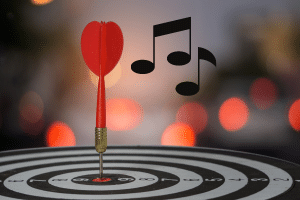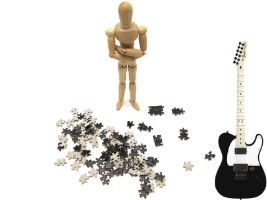
If you’re having trouble learning guitar solos, check out the things you can do that will take your playing to the next level. Then, start killing it every time!
It doesn’t matter if you play classical, country, or rock music. Great guitar solos all share the same basic structure and technical skill requirements.
Most people find it difficult to play guitar solos, especially when first starting on the instrument. It’s important to have a methodical approach to developing your soloing skills, no matter which instrument you play.
Let me help you make it a lot easier!
What Soloing Taught Me Over The Years

When I first started playing guitar many years ago, I copied riffs and bits of solos that I thought would impress my friends. Although I had a lot of fun and my playing did improve, I quickly hit a plateau.
It’s easy to find yourself playing the same licks and solo variations again and again.
It took me a few years to develop a more disciplined and methodical approach that eventually helped me become a decent player.
Over time, I developed and adopted several techniques that kept me moving into new musical territory.
Read on to discover what I learned and how you can use it to your ultimate benefit. If you already know the basics then scroll down to “3 Tricks For Playing And Remembering Great Solos.”

Should You Learn Guitar Solos?
The short answer is yes, but only if you want to. You are reading this article, so I’ll assume you’re at least curious, if not totally psyched, about being a soloist.
So, what are you waiting for? Maybe you’re thinking about buying your first guitar and want to be the next Jimmy Page or Joe Satriani. But, on the other hand, perhaps you have been playing rhythm guitar for a while and are now ready to step out into the spotlight.
Like anything worth learning, you have to take the first step to get started, and it takes practice and determination.
How long does it take to learn guitar solos?

The answer to this really depends on how experienced and skilled you are as a player and the difficulty of the guitar solo. It also depends on how accurate you want the solo to be.
If you want to learn an approximate version of the solo that your audience will recognize, it will take less time than a note-for-note version.
It’s ok (and fun) to play the first few bars of a solo accurately and then improvise around it to make it your own.
I’ve spent less than an hour learning easy-to-play solos and three months learning complicated ones!
Learning Guitar Solos For Beginners

If you’re a beginning player, then you probably want to dive right into how to learn guitar solos, especially if you play electric guitar. I say, the sooner, the better, but don’t forget to start with the basics.
Be sure to start with learning how to tune your guitar properly.
Ok, go ahead and laugh, but some beginners spend weeks trying to learn solos before they realize their instrument is out of tune. The first day I got a guitar I thought I would only have to check the tuning every month or so! Check your tuning each day before you start playing anything.
Start with a song that has an easy guitar solo, which is short and slow. When you first begin playing the guitar, you might be surprised at how even the easy stuff seems hard, but don’t get discouraged. It’s ok to put a difficult piece aside and come back to it after becoming a better player.
For more info, see How To Stay Motivated To Learn Guitar – Top Tips For Success.
Always learn the rhythm side of guitar playing, too. Remember, you will need a chord progression to solo over, and it’s important to understand how the connection between rhythm playing and soloing works so that your solo will sound good with the rest of the song.
Some of the best guitar soloists are also awesome rhythm players!
3 Tricks For Playing And Remembering Great Solos
Here are some things that will change your approach to learning to solo on guitar. Work on each item a little each day, and you will begin to see real improvement in your playing.

1. Target The Melody
Ever notice how some of the best guitar players in the world come up with solos that just seem to fit perfectly with the rest of the tune. Listen carefully, and you will notice that the solo is built around the song’s melody.
Players like David Gilmour, Steve Vai, and Robben Ford all have very different musical styles and technical skills. Still, they all frequently incorporate the melodic structure of the song into their solos.
I like to take two basic approaches to craft a melodic solo. The longer the solo, the more important it is to keep it melodic, or it will begin to sound more like a practice session and your audience will start to lose interest.
The “Melody-Noodle” Method
In this soloing approach, the tune’s melody is prominent and firmly established, after which melodic variations are added by “noodling around” on the fretboard to incorporate passages from scales and arpeggios, always returning to some form of the song’s melody.
This kind of improvisation makes your solo sound like it is a natural fit for the song. It’s a great soloing method for songs with lyrics, but you can also use it in instrumental pieces.
It usually works well because it satisfies the audience’s preconceived ideas or musical expectations based on the song’s words. When the singer steps out of the way to make room for the guitar solo, the audience is looking for and appreciates some type of “musical connectivity.”
If you don’t already have a well-established audience or you’re a beginning soloist then this will probably be the better method to use.

The “Noodle-Melody” Method
This is essentially the opposite approach, where you begin a solo with a series of riffs, scales, or arpeggios and then incorporate the underlying melodic structure of the song.
I tend to use this soloing method with instrumental pieces where you can’t rely on the audience’s affinity to the song’s words.
You’ve probably heard a cover of a well-known song where the soloing is so complex that you didn’t recognize it until the soloist plays the actual melody. This approach is commonly heard in some types of jazz.
The noodle-melody method will work for any genre of music but is usually well-received by an audience that is more “technically sophisticated,” such as a group of musicians or avid instrumental-music listeners.
I heard a jazz-fusion song on the radio while driving to work last week. I knew I had heard it before but I just couldn’t identify the name of the tune until the guitar player added a piece of the main melody.
Getting to that “aha moment” really held my interest but I can also see how it might be a bit annoying for some listeners, so know your audience!
2. Make It Memorable

Building your solo around a memorable lick or catchy melody is one of the best ways to create audience interest. These are the songs that make listeners want to crank up the volume and play air guitar.
One good way to create a song with a memorable lick is to open the tune with it and then repeat it a few times, so it becomes familiar to your audience.
Who doesn’t know the opening lick to the Rolling Stones tune “I Can’t Get No Satisfaction?” Likewise, the Beatles made an entire career out of writing awesome songs with memorable licks and catchy lyrics.
Remember the song “Day Tripper” by the Beatles or “Wipe Out” by The Surfaris? I’ll bet you can hum the opening guitar lines to these songs right now!
Don’t just use your memorable lick to open the song. Instead, bring it back whenever appropriate and embellish it now and again by making it longer or sticking it the solo.
Electronic effects like overdrive, distortion, reverb, echo, phaser, chorus, flanger, and wah-wah pedal can help make a lick memorable. For example, remember “Voodoo Child, Slight Return” by Jimi Hendrix? I’ve heard that song covered a hundred times by other artists, and no one ever plays it without using a wah-wah pedal on the opening lines, just like Jimi did it!

3. Be Conversational
The best speakers are dynamic and interesting, while others are boring and speak in a monotone. Guitar solos follow the same pattern.
A great solo tells a story in a way that makes sense and holds the listener’s interest. It has a beginning or introduction, a middle, and an end.
There are a variety of things that can make a guitar solo stand out, like speed, vibrato, and trills (rapidly alternating two adjacent notes), but “phrasing” is most important of all!

Here is an excellent way to come up with ideas for awesome guitar solos that you can remember how to play. Take several lines from your favorite movie that you can recite verbatim or from a book you enjoy reading (children’s rhyme books work especially well).
Recite the movie or book quote aloud while you add notes in a particular key using a scale, arpeggios, or just play something off-the-cuff.
Play one note for every syllable in each word. Be sure to add the same dynamics and attitude as the spoken line. For example, if it is spoken softly, then play that part softly. If it gets loud or expresses an attitude, then play it louder with dynamic emphasis on those notes.

Try creating a short solo from this memorable quote from the movie A Few Good Men. “You want answers?! I want the truth! You can’t handle the truth!”
Or, how about this masterpiece of a quote from The Cat In The Hat? “I know it is wet, and the sun is not sunny, but we can have lots of good fun that is funny.”
You’ll be surprised at how well this works, especially with one or two paragraphs from a book that you love and can easily recite from memory.
When you play this way your solo will sound more natural because you are modeling the way people speak.
How To Learn Difficult Guitar Solos

Break It Into Chunks
Copying or composing a guitar solo can be a bit overwhelming, especially if it’s technically difficult and you are a beginning player. If you become frustrated, it’s ok to stop and pick up where you left off tomorrow. You don’t try to figure it out all at once.
Tackle it a little at a time by breaking it into chunks. Thinking about a solo as the sum of smaller parts can help you learn or rearrange it more efficiently. Focus on one area at a time and then move onto the rest. Each musical chunk should have a natural starting and ending point, like a well-crafted spoken sentence.
If you love a guitar solo but find it intimidating to play or above your level of technical ability then omit the “challenging chunk” and learn the other parts.
Lock In On The Rhythm

Learning to lock in on the rhythm will do wonders for your musical timing and help make everything you play sound more professional.
Always practice with a metronome. One of the best ways to keep time is to tap your foot as you play, which is usually my metronome of choice. Begin slow and gradually increase the tempo until you can play the solo up to speed in perfect time with clean note articulation and no errors.
Once you master the solo with a metronome or “click track,” then play it over a backing track using the same process.

Get Help From Others
As you learn solo guitar, don’t be afraid to ask your friends or other more advanced guitar players in your band for help. Sometimes a little musical direction goes a long way!
The internet is loaded with instructional articles (you’re reading one of them right now) and videos to help you answer questions and solve problems.
You can always go “old school” and get help from a guitar teacher “one-on-one.” Don’t underestimate the value of this method because individualized guidance is one of the fastest ways to progress as a guitar player.
Learning Guitar Solos Note For Note

Learning to play a guitar solo exactly the way it was recorded can be a time-consuming endeavor, even if you are composing it.
Sometimes the original artist will play a solo a little differently in a live situation. Was it a mistake or done intentionally to create interest? If it was well-played you might never know.
If you are a beginning guitar player, start with solos that are easier to learn and remember, then slowly work your way to the more complicated stuff as you continue to improve.
Here are some of the things that will help you along the way.
Use Instructional Materials
There are various instructional materials these days that can help you speed up the learning process. You can use them on your own or in conjunction with a professional instructor. The choice is yours, and you should stick with whatever works best for you.
TABs For Learning Guitar Solos
Learning to read TABs (tablature) is a great way to nail solos note for note. If you read traditional musical notation, you can combine it with TABS to get the best of both worlds. The traditional notation will help you with timing and rhythm, while TABs will show you fretboard finger positions.
A professionally scored piece of music can save you hours of trying to figure things out by ear and dramatically improve the accuracy of how you play the solo.
Beware of TABS or sheet music that is inaccurate or have you playing the song’s lyrics instead of the actual guitar solo parts.

Apps For Learning Guitar Solos
There are many free and paid apps that you can use to learn the guitar rhythm and solo parts of a song, note for note. Check out some of the online resources such as Yousician, Fender Play, and Guitar Pro.
These apps show you how to play the music, but they also help you improve your timing and allow you to slow down the song’s speed to make it easier to learn. See the next section for more information on this technology.
Find Similarities
Try to find parts of the solo that are similar to other solos or licks that you already know. As you become more experienced, this will be a handy tool and a real timesaver.
This can often help you play and remember the solo because certain patterns are already in your “muscle memory” from previous training exercises.
After you learn to play a solo note for note, it’s ok to take what someone else has done and reinterpret it to make it your own. It may form the basis for an entirely new solo that fits perfectly into a song you just happen to be writing or inspire you to write something brand new.
Be careful not to accidentally steal other artist’s work, especially if you are recording.
How To Learn Fast Guitar Solos

Slow It Down And Loop It
Sometimes fast guitar solos have notes that are difficult to hear clearly because they all seem to “run together,” especially if it is played over a lot of background music.
Learn to take advantage of the apps that allow you to slow down a solo without changing its pitch. These programs can be purchased as stand-alone software or used online. Some of them will even allow you to isolate the solo by subtracting out other sounds.
I used to slow down the speed of record albums to figure out fast solos, but that also made the notes sound lower and a little weird. It was great fun and a little challenging but thank God for computers!
Make a “loop” (a playback that repeats automatically) of the solo and play a small section at a slow speed. Then, gradually speed it up until you can play it accurately at full tempo.
If your hand or wrist gets tired or you begin to experience discomfort, stop immediately and try it again the next day at a slower speed. You don’t want to develop tendinitis or carpal tunnel syndrome.
Record Yourself

Recording yourself while you play can really help you focus on what you need to work on most to improve your technical skills, especially for fast solos. It can be difficult to hear what you sound like while trying to concentrate on playing everything correctly.
Listen carefully to the playback to check the quality of your overall sound and technique.
If the recording sounds out of time or the notes don’t all sound clear, you are practicing the solo too fast. Most players are surprised when they hear what they would actually sound like to an audience.
Video recordings can be even more useful because you can identify specific problems with your technique visually.
It’s generally a good idea to record everything you play. Then, if you come up with a great lick during a practice session, you won’t have to try to remember it to add to your bag of tricks. What’s a bag of tricks? Read on!

Learning Guitar Solos By Ear
The more you play, the easier it will be to create and learn guitar solos by ear. Here are some things that you can do to make it easier to recognize what you hear and improve your improvisational skills.
Build Your “Bag Of Tricks”
Your bag of tricks is the go-to material that you can use as the building blocks for a guitar solo. Begin by learning classic riffs and cliche licks. Then, put them together to create something new and add some flashy tricks.
Strive to be innovative by using techniques (tricks) like string bending, natural or pinch harmonics, chicken picking, and the whammy bar.
Don’t be afraid to integrate this material into other solos, which will also help make it a permanent part of your musical vocabulary.
Here’s a video from “Fender Play” that shows you how to string bend in solos. Check it out!
Train Your Ear
The more you train your ear, the better you will become at learning and playing guitar solos. Unfortunately, many players undervalue ear training, which is an indispensable skill.
You can ear train informally by listening carefully to music and by learning music theory on your own. For example, try to recognize the key signature of songs or guitar solos.
Ear training will also help you combine rhythm with melody, like when using the “CAGED” system to solo around chords with arpeggios and scales.
Add some degree of ear training into every practice session, and you will see an impressive improvement in your ability to play great guitar solos.
Play “The Changes”
Instead of just soloing with one scale or “box pattern” in a particular key, try playing over the actual chords in the song.
For example, if you are playing a blues tune in the key of A, instead of playing the A minor pentatonic scale over all the chord changes, try playing a different scale over each of the A, D, and E chords.
Mix It Up
When you find a lick or solo passage you really like, mix it up by varying the rhythm and melody to create something new. This is a great way to expand your musical vocabulary and create solos that take the listener on a journey.
You can create tons of new material from just a single idea in a very short period of time. This will also help you branch out musically, making it easier to play what’s in your head or what you heard someone else play.
Go To Concerts And Watch Music Videos

The no substitute for watching your favorite guitarist actually play a riff or solo that you always wanted to learn. Perhaps you can play a reasonable facsimile, but you can’t figure out why it doesn’t sound exactly right.
There are many ways to play a solo, and subtleties can make all the difference. For example, the exact note played on two different strings or fingerboard positions can change the whole sound of the solo.
There are thousands of concerts available to buy or stream on video. I make it a point to watch at least one a week while I relax on my couch with a guitar close at hand. You never know when you will hit the pause button and try playing it yourself.

Final Thoughts On Learning Guitar Solos
Playing guitar solos can be fun, exciting, and challenging. However, becoming an excellent soloist takes practice, dedication, and perseverance.
If you are a beginner, don’t let the idea of playing guitar solos frighten you or limit your ability to become expressive on your instrument. Even the players you admire started playing simple solos, and so can you!
When you learn a guitar solo, choose or compose something that coincides with your skill level but always challenge yourself to go further and get better. To progress as a soloist, it’s important to take yourself a little outside your comfort zone.
If you find a solo too difficult to play, don’t stress out about it. It’s ok to put it aside and come back to it another day or when you are a more accomplished player.
Here is the magic formula for success. Get psyched about playing guitar solos, practice routinely, use the tips and tricks in this article, emulate your favorite players, and ultimately strive to find your own soloing style that is “uniquely you.”
For more info, see How To Relax When Playing Guitar – 8 Best Tips And Tricks!
What To Read Next ➡ How Long Should A Guitar Solo Be? – Rockstar Revelations!

Tell Me What You Think
Would you please let me know what’s on your mind in the comment section or if I can help you with anything?
- Are you thinking about playing guitar solos? What’s been stopping you?
- What are you currently doing to improve your guitar solos ?
- Do you learn guitar solos by ear or do you use sheet music?
- Any tips to share on learinng guitar solos and how are they helpful?
- Did you find this article helpul? Did it motivate you to begin learning how to solo on the guitar?




Hello Frank, this is a great post about learning guitar solos but before I do that I have to get better at playing the guitar. This is something that I always wanted to learn how to do well. I really like the section for beginners. this is very applicable to my skill level. Thank you for the inspiration. I will definitely start with making sure that I know how to tune my guitar properly.
Hi, Anna
I really appreciate your comments!
You certainly have the right attitude; just keep working on it. We all start at the beginning and learn as we go. It helps if you make yourself a basic practice schedule to play more methodically and progress consistently.
Think about joining a local band. Find other people at about your skill level or better, who play the kind of music you enjoy. They will show you all kinds of great stuff.
Definitely get an electronic guitar tuner and use it each time before you play. Then, listen carefully to each note that comes out of your guitar, and it will all become second nature!
Come back and visit my site often. There will be lots of helpful articles for beginners.
Frank
Hello Frank, Your site is really impressive and you provide a lot of useful information on every topic and explain it in detail. From your site, I get that it’s really fun and exciting. I don’t know anything about guitar and I always wished to learn guitar and I’ll at least try. Thank you for your wonderful article and I hope people find it useful.
Hi, Raja
Thank You for your comments!
The best approach to learning to play guitar is just to take that first step! Buy a guitar (you don’t have to spend a lot of money), or you can even borrow one from a friend. Start by learning a few basic chords and melodies, and then just keep on going.
The key is to play every day but remember to keep it fun! Before you know it, you’ll be hooked and on your way to becoming a great player!
Let me know if there’s anything I can help you with, and please come back to visit my site often.
Frank
Hi, Frank,
I really enjoyed reading this article and you have inspired me to finally get serious about learning lead, I have put it off long enough. My problem is that everyone wants me to sing and is very happy with my guitar playing. And although I appreciate the compliment to my singing it doesn’t really encourage me to play the lead (which I find a daunting task).
But you have given me some great ideas on how to get started. I’m not a beginner so I can read music and tab and I have lessons every week with my friend who is an amazing guitarist. So, what is stopping me, I don’t know?
Perhaps I will try learning the lead to ‘Albatross’ first as I already play the rhythm for my teacher. A place to start.
Thanks for your great advice, I’m going to bookmark this page for future reference and try one of the apps you suggested.
Lily
Hi, Lily
I really appreciate your comments!
Here’s what I recommend. Just totally relax and have fun learning how to play various leads. They will sound better and better as you continue to practice.
Start with a simple scale, like the minor pentatonic. Record a I, IV, V chord structure using “power chords” (1-5-8) in any key, like the key of A. Play the same A minor pentatonic notes over each power chord (A5,D5 & E5).
When you become comfortable with that then play A minor pentatonic notes over A5, D minor pentatonic over D5, and E minor pentatonic over E5.
Find these power chords all over the neck and learn how to play the scale in those positions and then in all key signatures.
Try it over your favorite songs. Play along with the recording and don’t be afraid of making mistakes, just have fun. Copy as many short licks as you can along the way. They don’t have to be exact, just the general idea is OK.
This will totally get you started and then you can continue to advance from there, like learning more complex chords in all the “CAGED” forms and playing the appropriate scales or arpeggios over them in various areas of the neck.
I’m sure that you will surprise yourself and advance very rapidly, especially with your musical background! ???
Have fun and play as much as you can!
Frank
Thanks for the encouragement, Frank. I will try this today and start having more fun. I do tend to take it too seriously and that’s not why I play.
Excellent! Do let me know how you make out. ??
One of the first things you’ll learn as a beginner guitar player is the proper way to play guitar chords. Understanding the proper technique to play guitar chords is one of the most important things you’ll learn to do guitar lead solos.
Hi, Jessie
Thank You for your comments!
I agree. Learning to solo around chord progressions is a key strategy, especially for Jazz improvisation. Another good approach is using the “CAGED” system to play scales or arpeggios in these chord positions. Many guitarists begin with soloing in a particular key using the minor pentatonic scale, blues scale, and major pentatonic scale. This is another valid approach, especially if you are a rock or blues player.
Frank